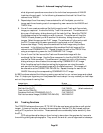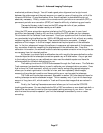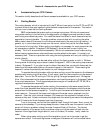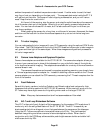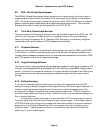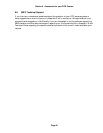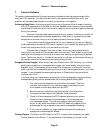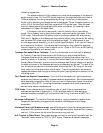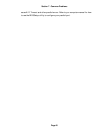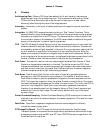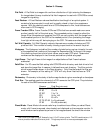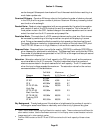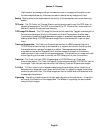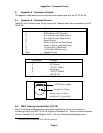Section 7 - Common Problems
Page 44
following suggestions.
The easiest method of finding objects is to use a reticule eyepiece, if the object is
bright enough to see. Pull the CCD optical head from the eyepiece holder and insert a
12-20mm eyepiece, focussing the eyepiece by sliding it in and out of the eyepiece
holder, not by adjusting the telescope's focus mechanism. Center the object carefully (to
within 10% of the total field) and then replace the CCD optical head. Since the head
was fully seated against the eyepiece holder when you started, fully seating it upon
replacement will assure the same focus.
If the object is too dim to see visually you will have to rely on your setting
circles. Go to a nearby star or object that is easily visible and center that object in the
CCD image. Calibrate your RA setting circle on the known object's RA and note any
DEC errors. Reposition the telescope at the intended object, using the correct RA setting
and the same DEC offset noted with the calibration object. Try a ten second or one
minute exposure and hopefully you will have winged the object. If not you will have to
hunt around for the object. You can use the Focus mode in Low resolution mode for
this and hopefully you won't have to search too far. Check in DEC first, as DEC setting
circles are often smaller and less accurate.
Telescope Port doesn't Move Telescope - If you find the camera is not moving the telescope
for Tracking, Track and Accumulate or Self Guiding you should use the Move
Telescope command with a several second period to isolate the problem down to a
specific direction or directions. If you set the Camera Resolution to the Low mode in the
Camera Setup Command, you can move the telescope and Grab an image fairly quickly
to detect movement of the telescope pointed at a moderately bright star. Try each of the
four directions and see which ones move and which ones don't. At this point the most
likely culprit is the hand controller modification. Trace the signals from the camera's
telescope connector back through the hand controller, paying particular attention to the
offending wires.
Can't Reach Low Setpoint Temperatures - If you find that the camera isn't getting as cold as
expected the problem is probably increased ambient temperatures. While these cameras
have temperature regulation, they still can only cool a fixed amount below the ambient
temperature (30 to 40 °C). Lowering the ambient temperature allows the cameras to
achieve lower setpoint temperatures.
CCD Frosts - If your camera starts to frost after a year of use it's time to regenerate the
desiccant as described in Appendix C. This is a simple matter of unscrewing the
desiccant container and baking it (without the little O-ring) in an oven at 350°F for 4
hours.
No Image is Displayed - Try the Auto Contrast setting or use the crosshairs to examine the
image pixel values and pick appropriate values for the Background and Range
parameters.
Horizontal Faint Light Streaks in Image - some PCs apparently have the mouse generate non-
maskable interrupts when moved. These interrupts can slightly brighten the line being
read out. If this occurs, do not move the mouse during read out.
A/D Timeout or Other Errors - Some compters require that you configure the parallel port for
"Standard" mode instead of "ECP" or "EPP" mode. These two enhanced modes can



